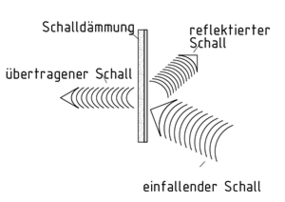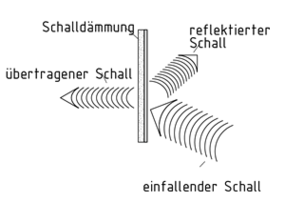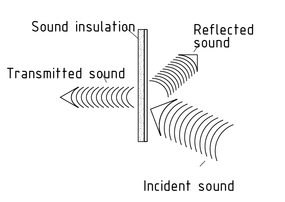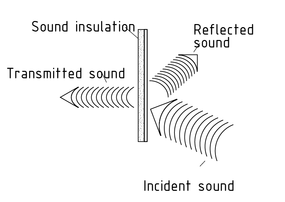
Choose one
or multiple languages
0,1,1
- German
- English
- Chinese
- Spanish
Sound insulation

Sound insulation is designed to impede or prevent the propagation of airborne and solid-borne sound by reflecting it as it crosses between two media. For example, rooms can be separated acoustically using special insulation designed to muffle footfall noise.
The effect of an insulating measure, i.e. how much sound it reflects, is indicated by the dimensionless sound pressure reflection coefficient r. It is the quotient of the sound pressure of the reflected sound wave and the sound pressure of the incident sound wave.
The sound Reduction index R is the ratio between the sound intensity that is measured at a partition and the sound intensity that passes through the partition. It varies according to the frequency and angle of incidence of the sound waves. High sound transmission losses R indicate low sound transmission and good insulating performance.
By contrast, sound Damping and sound absorption are measures implemented in the room itself that are designed to absorb sound energy and convert it to heat energy.
Schalldämmung

Eine Schalldämmung soll die Ausbreitung von Luft- und Körperschall durch Reflexion beim Übergang zwischen zwei Medien behindern oder verhindern. So werden Räume akustisch durch eine Trittschalldämmung getrennt.
Die Wirkung einer Dämmmaßnahme, d. h. die Größe der Reflexion, wird durch den dimensionslosen Schallreflexionsfaktor r angegeben. Er ist der Quotient aus dem Schalldrucks der reflektierten und dem Schalldruck der einfallenden Schallwelle.
Das Schalldämmmaß R ist das Verhältnis der auf eine Trennschicht auftreffenden und der durchgelassenen der Schallintensität. Es hängt von Frequenz und Einfallswinkel der Schallwellen ab. Hohe Schalldämmmaße R bedeuten eine geringe Schallübertragung und eine gute Dämmleistung.
Schalldämpfung und Schallabsorption sind dagegen Maßnahmen im Raum selbst, bei denen Schallenergie absorbiert und in Wärmeenergie umgewandelt wird.
隔声

隔声是指声波在两种介质之间传播时,通过障碍物反射而阻碍或阻止空气传声和固体传声。例如,房间之间可以使用特殊的隔声材料而彼此声学独立,以消除脚步声。
隔声措施的效果,即它能够反射多少声音,是由无量纲的声压反射系数 r 来表示。它等于反射声波的声压与入射声波的声压的商值。
隔声量R是穿透前测得的声强和穿透后测得的声强的比值。它取决于声波的频率和入射角度。传声损失 R 值大表明传声效果差、隔声效果好。
房间内对声音的阻尼和吸收的措施旨在吸收声能并将其转化为热能。
隔声措施的原理
Aislamiento acústico

El aislamiento acústico está diseñado para impedir o prevenir la propagación del sonido portado por aire o por sólidos al reflejarlo mientras cruza entre dos medios. Por ejemplo, las habitaciones pueden ser separadas acústicamente usando aislantes especiales diseñados para amortiguar el ruido de las pisadas.
El efecto de una medida aislante, es decir, cuánto sonido refleja, es indicado por el coeficiente de reflexión de la presión de sonido sin dimensiones r. Es el coeficiente de la presión del sonido de la onda de sonido reflejada y la presión de sonido de la onda de sonido incidente.
El índice de reducción de sonido R es la relación entre la intensidad del sonido que se mide en una división y la intensidad del sonido que pasa a través de la división. Varía de acuerdo con la frecuencia y ángulo de incidencia de las ondas de sonido. Las pérdidas de transmisión de alto sonido R indican una baja transmisión de sonido y un buen desempeño del aislante.
En contraste, la y la absorción de sonido son medidas implementadas en una habitación que está diseñadan para absorber la energía de sonido y convertirla en energía calórica.
Cómo funciona el aislante acústico
